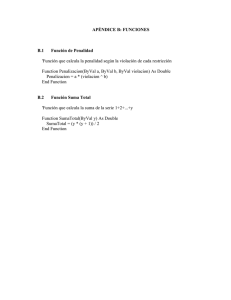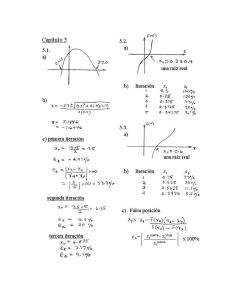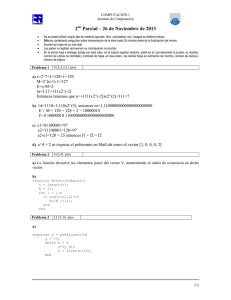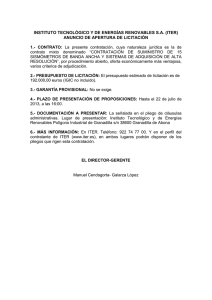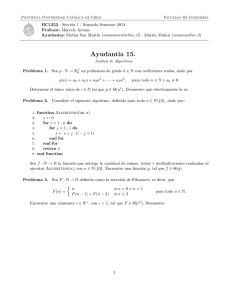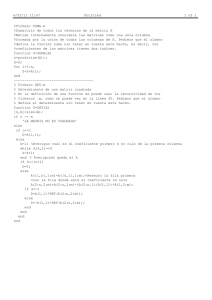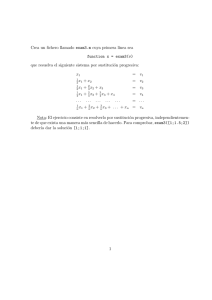CHAPTER 2
Anuncio
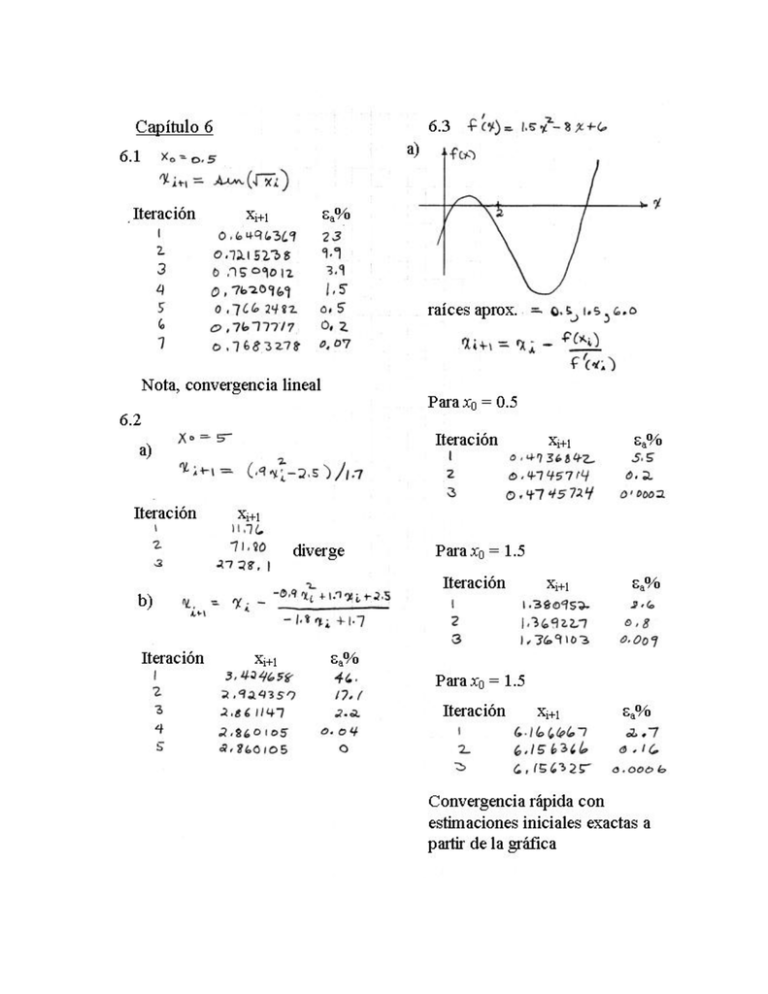
6.16 Se presenta un programa en VBA para implementar el algoritmo de Newton-Raphson y resolver el ejemplo 6.3. Option Explicit Sub NewtRaph() Dim imax As Integer, iter As Integer Dim x0 As Single, es As Single, ea As Single x0 = 0# es = 0.01 imax = 20 MsgBox "Raíz: " & NewtR(x0, es, imax, iter, ea) MsgBox "Iteraciones: " & iter MsgBox "Error estimado: " & ea End Sub Function df(x) df = -Exp(-x) - 1# End Function Function f(x) f = Exp(-x) - x End Function Function NewtR(x0, es, imax, iter, ea) Dim xr As Single, xrvie As Single xr = x0 iter = 0 Do xrvie = xr xr = xr - f(xr) / df(xr) iter = iter + 1 If (xr <> 0) Then ea = Abs((xr - xrvie) / xr) * 100 End If If ea < es Or iter >= imax Then Exit Do Loop NewtR = xr End Function Su aplicación produce una raíz de 0.5671433 después de 4 iteraciones. El error aproximado en este punto es 2.1×10−5 %. 6.17 Se presenta un programa en VBA para implementar el agoritmo de secante y resolver el ejemplo 6.6. Option Explicit Sub SecMain() Dim imax As Integer, iter As Integer Dim x0 As Single, x1 As Single, xr As Single Dim es As Single, ea As Single x0 = 0 x1 = 1 es = 0.01 imax = 20 MsgBox "Raíz: " & Secant(x0, x1, xr, es, imax, iter, ea) MsgBox "Iteraciones: " & iter MsgBox "Error estimado: " & ea End Sub Function f(x) f = Exp(-x) - x End Function Function Secant(x0, x1, xr, es, imax, iter, ea) xr = x1 iter = 0 Do xr = x1 - f(x1) * (x0 - x1) / (f(x0) - f(x1)) iter = iter + 1 If (xr <> 0) Then ea = Abs((xr - x1) / xr) * 100 End If If ea < es Or iter >= imax Then Exit Do x0 = x1 x1 = xr Loop Secant = xr End Function Su aplicación produce una raíz de 0.5671433 después de 4 iteraciones. El error aproximado en este punto es 4.77×10−3 %. 6.18 Se presenta un programa en VBA para implementar el algoritmo de secante modificado y resolver el ejemplo 6.8. Option Explicit Sub SecMod() Dim imax As Integer, iter As Integer Dim x As Single, es As Single, ea As Single x = 1 es = 0.01 imax = 20 MsgBox "Raíz: " & ModSecant(x, es, imax, iter, ea) MsgBox "Iteraciones: " & iter MsgBox "Error estimado: " & ea End Sub Function f(x) f = Exp(-x) - x End Function Function ModSecant(x, es, imax, iter, ea) Dim xr As Single, xrvie As Single, fr As Single Const del As Single = 0.01 xr = x iter = 0 Do xrvie = xr fr = f(xr) xr = xr - fr * del * xr / (f(xr + del * xr) - fr) iter = iter + 1 If (xr <> 0) Then ea = Abs((xr - xrvie) / xr) * 100 End If If ea < es Or iter >= imax Then Exit Do Loop ModSecant = xr End Function Su aplicación produce una raíz de 0.5671433 después de 4 iteraciones. El error aproximado en este punto es 3.15×10−5 %. 6.19 Se presenta el programa en VBA para implementar el método de la 2a. ecuación de Newton-Raphson y resolver el ejemplo 6.10. Option Explicit Sub NewtRaphSyst() Dim Dim Dim Dim imax As Integer, x0 As Single, y0 xr As Single, yr es As Single, ea iter As Integer As Single As Single As Single x0 = 1.5 y0 = 3.5 es = 0.01 imax = 20 Call NR2Eqs(x0, y0, xr, yr, es, imax, iter, ea) MsgBox "x, y = " & xr & ", " & yr MsgBox "Iteraciones: " & iter MsgBox "Error estimado: " & ea End Sub Sub NR2Eqs(x0, y0, xr, yr, es, imax, iter, ea) Dim J As Single, eay As Single iter = 0 Do J = dudx(x0, y0) * dvdy(x0, y0) - dudy(x0, y0) * dvdx(x0, y0) xr = x0 - (u(x0, y0) * dvdy(x0, y0) - v(x0, y0) * dudy(x0, y0)) / J yr = y0 - (v(x0, y0) * dudx(x0, y0) - u(x0, y0) * dvdx(x0, y0)) / J iter = iter + 1 If (xr <> 0) Then ea = Abs((xr - x0) / xr) * 100 End If If (xr <> 0) Then eay = Abs((yr - y0) / yr) * 100 End If If eay > ea Then ea = eay If ea < es Or iter >= imax Then Exit Do x0 = xr y0 = yr Loop End Sub Function u(x, y) u = x ^ 2 + x * y - 10 End Function Function v(x, y) v = y + 3 * x * y ^ 2 - 57 End Function Function dudx(x, y) dudx = 2 * x + y End Function Function dudy(x, y) dudy = x End Function Function dvdx(x, y) dvdx = 3 * y ^ 2 End Function Function dvdy(x, y) dvdy = 1 + 6 * x * y End Function Su aplicación produce una raíz de x = 2 y y = 3 después de 4 iteraciones. El error aproximado en este punto es 1.59×10−5 %. 6.20 El programa del problema 6.19 se puede configurar para resolver el problema 6.11, cambiando las funciones a Function u(x, y) u = y + x ^ 2 - 0.5 - x End Function Function v(x, y) v = x ^ 2 - 5 * x * y - y End Function Function dudx(x, y) dudx = 2 * x - 1 End Function Function dudy(x, y) dudy = 1 End Function Function dvdx(x, y) dvdx = 2 * x ^ 2 - 5 * y End Function Function dvdy(x, y) dvdy = -5 * x End Function Usando un criterio de parado de 0.01%, el programa produce x = 1.233318 y y = 0.212245 después de 7 iteraciones con un error aproximado de 2.2×10−4. El programa del problema 6.19 se puede configurar para resolver el problema 6.12, cambiando las funciones a Function u(x, y) u = (x - 4) ^ 2 + (y - 4) ^ 2 - 4 End Function Function v(x, y) v = x ^ 2 + y ^ 2 - 16 End Function Function dudx(x, y) dudx = 2 * (x - 4) End Function Function dudy(x, y) dudy = 2 * (y - 4) End Function Function dvdx(x, y) dvdx = 2 * x End Function Function dvdy(x, y) dvdy = 2 * y End Function Usando un criterio de parado de 0.01% y estimaciones iniciales de 2 y 3.5, el programa produce x = 2.0888542 y y = 3.411438 después de 3 iteraciones con un error aproximado de 9.8×10−4. Usando un criterio de parado de 0.01% y estimaciones iniciales de 3.5 y 2, el programa produce x = 3.411438 y y = 2.0888542 after 3 después de 3 iteraciones con un error aproximado de 9.8×10−4. 6.21 x= a x2 = a f ( x) = x 2 − a = 0 f ' ( x) = 2 x Sustituir en la fórmula de Newton Raphson (Ec. 6.6), x2 − a 2x x = x− Combinando términos se obtiene x= 2 x( x) − x 2 + a x 2 + a / x = 2 2 6.22 SOLUCIÓN: ( f (x ) = tanh x 2 − 9 [ ( ) )] f ' ( x ) = sech 2 x 2 − 9 (2 x ) x o = 3 .1 xi +1 = xi − f (x ) f ' (x ) iteración xi+1 1 2 3 4 2.9753 3.2267 2.5774 7.9865 La solución diverge de su raíz real de x = 3. Debido a la concavidad de la pendiente, la siguiente iteración divergirá siempre. El bosquejo debe parecerse a la figura 6.6(a). 6.23 SOLUCIÓN: f ( x) = 0.0074 x 4 − 0.284 x 3 + 3.355 x 2 − 12.183 x + 5 f ' ( x) = 0.0296 x 3 − 0.852 x 2 + 6.71x − 12.183 f ( xi ) f ' ( xi ) xi +1 = xi − i 1 2 3 xi+1 9.0767 -4.01014 -3.2726 La solución converge sobre otra raíz. Las soluciones parciales para cada iteración intersectan el eje x a lo largo de la trayectoria tangente después de una raíz diferente, resultando en una convergencia en otra parte. 6.24 SOLUCIÓN: f(x) = ± 16 − ( x + 1) 2 + 2 xi +1 = xi − f ( xi )( xi −1 − xi ) f ( xi −1 ) − f ( xi ) 1ra iteración xi −1 = 0.5 ⇒ f ( xi −1 ) = −1.708 xi = 3 ⇒ f ( xi ) = 2 2(0.5 − 3) xi +1 = 3 − = 1.6516 ( −1.708 − 2) 2da iteración xi = 1.6516 ⇒ f ( xi ) = −0.9948 xi −1 = 0.5 ⇒ f ( xi −1 ) = −1.46 xi +1 = 1.6516 − − 0.9948(0.5 − 1.6516) = 4.1142 (−1.46 − −0.9948) La solución diverge porque la secante creada por los dos valores de x, produce una solución fuera del dominio de las funciones.
